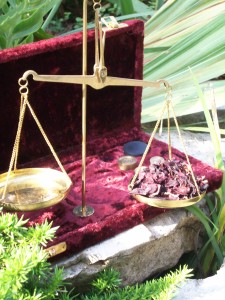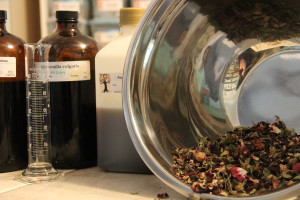How herbs are taken at home depends on how the herb works with different preparations, as well as the preferences of the client. Dr. Fidler grows approximately 30 of the herbs used and buys the rest from organic growers – as much as possible locally. RH understands that when a client is comfortable with the method, they are more able to adhere to recommendations. These are the primary applications currently used.
 Herbal extracts are made with alcohol and water and are called tinctures. The herbs are pressed at room temperature as heat denatures (destroys how well the plant works) the delicate plant chemicals. An example would be vanilla extract, although this is a culinary tincture. 1 tsp=5ml 1½ tsp=7.5ml
Herbal extracts are made with alcohol and water and are called tinctures. The herbs are pressed at room temperature as heat denatures (destroys how well the plant works) the delicate plant chemicals. An example would be vanilla extract, although this is a culinary tincture. 1 tsp=5ml 1½ tsp=7.5ml
Tinctures are usually taken before meals with a little water.
Reuduce the tiny amount of alcohol in each serving by measuring the tincture into a cup and pouring hot water over it. Allow it to cool and most of the remaining alcohol will have evaporated.
Teas are fresh or dried herbs in boiling water. Boil water on the stove (never a microwave), pour over 2 tsp of dried herbs per cup, then cover and steep for 10-15 minutes. It can be sweeten with Stevia, and add lemon, ginger, cinnamon etc. to taste. A days’ supply (3 cups) can be brewed ahead of time, but no more than 12 hours before.
Syrups are made from boiled down herbs and a sweet preservative added, such as glycerine or honey. They are used mostly for coughs – the Thyme and Licorice syrup is effective and quite popular.
Dried herbs and herb blends can be made into capsules or tablets, but these are not as readily available to the body as tinctures and teas. Dr. Fidler carefully sources these herbs from reputable suppliers like Apex Energetics, Standard Process, Natura and Innate Response. Occasionally capsules will be made for special order. 
Herbs in either oil or tincture can be blended into salves or creams in a variety of bases, usually an infused oil with Vitamin E added or fresh aloe juice. The oil holds the herb against the skin for greater absorption and increases the amount of time it is available for use.
Powders are herbs that need to be blended with a little warm or cold water. Slippery elm is the one most commonly used for reflux, sore throats and any bowel disturbance. It is a good prebiotic-it helps nourishes healthy gut bacteria. Usually ½-2 tsp in warm water 2-3 times a day is effective.
Suppositories are made from a blend of dry herbs in chilled coconut oil thickened with a little beeswax. They are very useful for children or when the digestive system is too disturbed to take the herbs orally. They are also good when the herbs need a localized effect.
 A blend of tinctures, essential oils, and water-extracted herbs can be made into a spray and applied to the skin when needed. A cooling spray is great for poison ivy – it reduces itching, helps prevent blistering and cools the inflammation. Dr. Fidler likes to keep hers in the fridge for additional relief. Spray as often as needed.
A blend of tinctures, essential oils, and water-extracted herbs can be made into a spray and applied to the skin when needed. A cooling spray is great for poison ivy – it reduces itching, helps prevent blistering and cools the inflammation. Dr. Fidler likes to keep hers in the fridge for additional relief. Spray as often as needed.
A decoction is for making stronger solutions from denser herb material like roots.  For best results, soak the herbs over night in a steel pan, before boiling up in the morning. Usual decotions use 2 tsp of herbs to 1 cup water, which translates to 1 cup to 16 cups if making a large quantity. (30-40 g per liter/~quart)
For best results, soak the herbs over night in a steel pan, before boiling up in the morning. Usual decotions use 2 tsp of herbs to 1 cup water, which translates to 1 cup to 16 cups if making a large quantity. (30-40 g per liter/~quart)
Boil the herbs gently until the volume of water has reduced by a half. Pour this water off and put it in a lidded container. Cover the herbs again with the same quantity of water, boil again gently until it is reduced by half. Pour off this liquid into the container you have chosen. If you can strain the herbs through a cloth or strainer you will get a higher yield for your efforts.
Cover the container and store in the fridge. If you have made up more than you need for three days, freeze it in labelled freezer-safe containers.
The usual dose is 1 cup, 2 times a day for adults, but the herbalist will advise on the amount you personally need.
 Herbal extracts are made with alcohol and water and are called tinctures. The herbs are pressed at room temperature as heat denatures (destroys how well the plant works) the delicate plant chemicals. An example would be vanilla extract, although this is a culinary tincture. 1 tsp=5ml 1½ tsp=7.5ml
Herbal extracts are made with alcohol and water and are called tinctures. The herbs are pressed at room temperature as heat denatures (destroys how well the plant works) the delicate plant chemicals. An example would be vanilla extract, although this is a culinary tincture. 1 tsp=5ml 1½ tsp=7.5ml 
 A blend of tinctures, essential oils, and water-extracted herbs can be made into a spray and applied to the skin when needed. A cooling spray is great for poison ivy – it reduces itching, helps prevent blistering and cools the inflammation. Dr. Fidler likes to keep hers in the fridge for additional relief. Spray as often as needed.
A blend of tinctures, essential oils, and water-extracted herbs can be made into a spray and applied to the skin when needed. A cooling spray is great for poison ivy – it reduces itching, helps prevent blistering and cools the inflammation. Dr. Fidler likes to keep hers in the fridge for additional relief. Spray as often as needed. For best results, soak the herbs over night in a steel pan, before boiling up in the morning. Usual decotions use 2 tsp of herbs to 1 cup water, which translates to 1 cup to 16 cups if making a large quantity. (30-40 g per liter/~quart)
For best results, soak the herbs over night in a steel pan, before boiling up in the morning. Usual decotions use 2 tsp of herbs to 1 cup water, which translates to 1 cup to 16 cups if making a large quantity. (30-40 g per liter/~quart)
